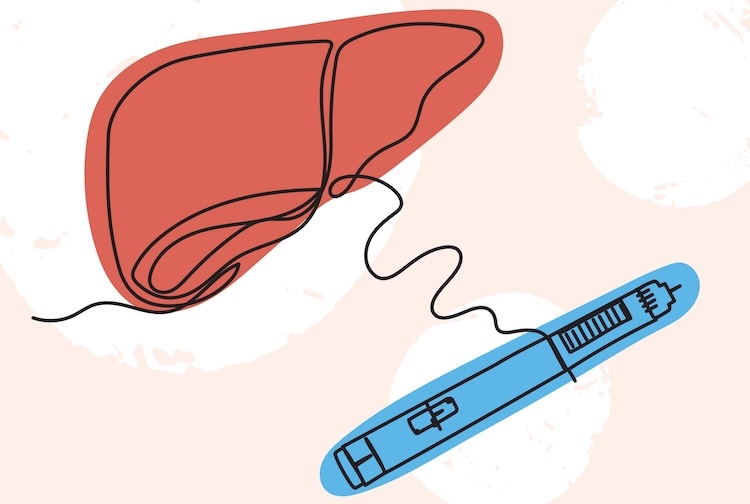How a drug for diabetes and obesity may help heal the liver
The director of VCU’s liver institute says a substance found in medications like Wegovy and Ozempic can address not only metabolic issues facing patients with liver disease but the liver disease itself.
June 17, 2025 Researchers are seeing connections between a compound found in GLP-1 receptor agonists and improved liver health. (Getty Images)
Researchers are seeing connections between a compound found in GLP-1 receptor agonists and improved liver health. (Getty Images)
Editor's Note: This story was updated to reflect new information about the federal approval of Wegovy to treat patients with MASH. (Updated: August 19, 2025)
By A.J. Hostetler
Preventing cancer. Alleviating alcohol cravings. Reducing the risk of cardiovascular problems. These are just some of the other uses doctors and researchers see for medications like Wegovy and Ozempic, used to treat obesity and diabetes.
It seems almost impossible for one type of drug to be the solution to so many ailments. However, it appears GLP-1 receptor agonists like Wegovy, and perhaps others such as tirzepatide, retatrutide and survodutide, may also help treat one of the most common illnesses in the world that is often hidden in plain sight – fatty liver disease.
In August, the U.S. Food and Drug Administration approved the use of Wegovy to treat metabolic dysfunction-associated steatohepatitis (MASH) in adults with excessive scar tissue in the liver. A research team led by Arun Sanyal, M.D., director of Virginia Commonwealth University’s Stravitz-Sanyal Institute for Liver Disease and Metabolic Health, and Philip Newsome, Ph.D., of King’s College London, has been involved in the clinical trials exploring the potential of semaglutide – the GLP-1 receptor agonist used for Wegovy and Ozempic – to treat people with this type of liver disease. The study, as with most research testing the efficacy and safety of a drug, was funded by the semaglutide manufacturer Novo Nordisk.
Results from their clinical trial, published in the New England Journal of Medicine in May, suggest that the substance found in diabetes and weight loss medications can halt and even reverse a common liver disease that affects millions worldwide.
“The results from this landmark study across 37 countries provide strong evidence that semaglutide can help patients with MASH by not only improving liver health, but also addressing the underlying metabolic issues that contribute to the disease,” said Sanyal, who is also a professor of medicine at the VCU School of Medicine.
VCU Health News spoke with Sanyal to learn more about why a drug used to treat obesity and diabetes could also hold promise to treat fatty liver disease.
What kind of medications is semaglutide found in? What does it do to the body?
Semaglutide is the main ingredient in Ozempic and Wegovy. GLP-1 receptor agonist medications like semaglutide work by mimicking the naturally occurring hormone GLP-1, which is made in your small intestine. GLP-1 medications bind to GLP receptors to trigger the GLP-1 hormone to work.
The drugs make you feel full, so you tend to reduce the amount of food you eat. You have a smaller appetite, and you don’t feel hungry, leading to weight loss.
If you have Type 2 diabetes, the medications help manage your blood sugar by triggering your pancreas to release more insulin. The slowed digestion also helps decrease blood sugar spikes.
You have been involved with studies to see how semaglutide impacts liver disease. How has this drug affected patients involved in clinical trials?
Most people did fine on semaglutide. Nearly 90% stayed on the drug for more than a year. About two-thirds of them had less liver swelling. More than a third had less scarring (fibrosis) of their liver. Another third saw improvements in both swelling and scarring. Participants lost weight and their heart health seemed to improve too.
How common is this liver disease? How does it affect your liver health in the long term?
Fatty liver disease is very common, affecting about 30% of people worldwide.
All the participants in our study have a fatty liver disease called MASH, which stands for metabolic dysfunction-associated steatohepatitis. It happens when too much fat builds up in the liver. This can cause swelling, damage, and scarring in the liver. Over time, it can lead to cirrhosis, liver failure, liver cancer or the need for a transplant. About 15 million people in the United States may have it. That’s around 1 in 20 adults.
Why are these findings a big deal for treating liver disease?
Hepatologists are really excited about the findings because right now there’s only one approved medicine for MASH and it was approved only last year. We physicians always want more than one therapy because not everyone responds 100% to any treatment. If semaglutide gets approved, it could give us doctors another way to help millions of people.
What are the next steps for research on semaglutide becoming a potential treatment for liver disease?
Our team will keep watching the participants in the study for five years. We want to see how well semaglutide works over time and if it can not only treat but prevent serious liver problems. Our ultimate goal is to find the right balance of semaglutide to resolve the damage caused by the fat buildup in the liver while at the same time help heal the scarring. Both are crucial for improving liver health in patients with MASH.
I’m also studying several other drugs that are similar to semaglutide to see if they can treat MASH. A couple of them are now in phase 3 clinical trials and we hope to have results in a year or two. Some of them seem really promising, possibly game-changers for liver patients.
Is semaglutide approved for treating MASH?
In August, semaglutide (Wegovy) received approval from the U.S. Food and Drug Administration to treat MASH in adult patients with moderate-to-advanced scarring of the liver, along with diet and exercise. It is not currently approved to treat cirrhosis. This approval was based on the results of the ongoing clinical trials.
See how VCU’s Stravitz-Sanyal Institute for Liver Disease and Metabolic Health is making an impact




